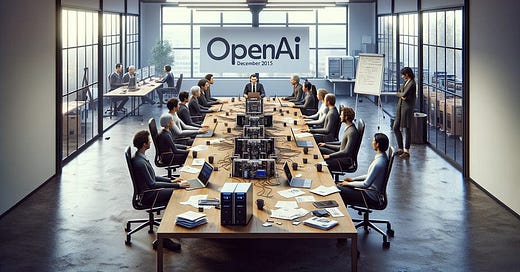The Full Story of What Happened at OpenAI: A Complete Detailled Timeline
A Comprehensive Overview From the Early Beginnings in 2015 Until the Recent Firing of Sam Altman And Beyond..
OpenAI, a leader in artificial intelligence, recently faced a whirlwind of events, reshaping its leadership and relationship with Microsoft.
The story, centered around CEO Sam Altman, is a mix of corporate drama, technological advancement, and strategic shifts.
Let’s break down what happened in simple terms, from Altman’s firing to his dramatic return, and how Microsoft played a key role in these changes.
But before we dive deep into the news about Altman’s return, let’s head back a bit and look at the history of OpenAI..:
2015–2018: Non-profit Beginnings
December 2015: Formation of OpenAI announced by Sam Altman, Greg Brockman, Elon Musk, and others, with a pledge of over $1 billion. Actual contributions totaled $130 million until 2019. Musk was its largest donor. OpenAI’s mission was to collaborate freely and make its research public.
April 2016: Release of “OpenAI Gym” for reinforcement learning research. Nvidia gifted its first DGX-1 supercomputer to OpenAI.
2017: OpenAI’s cloud computing expenses reached $7.9 million.
2018: Elon Musk resigned from the board, citing potential conflicts of interest with Tesla’s AI development.
2019: Transition to Capped-Profit
February 2019: Announcement of GPT-2, known for its human-like text generation capabilities.
2019: Transition from non-profit to capped-profit, with a profit cap of 100 times any investment. OpenAI partnered with Microsoft, receiving a $1 billion investment package.
2020–Present: ChatGPT, DALL-E, and Microsoft Partnership
2020: Launch of GPT-3, a language model for various applications including question answering and text generation.
2021: Introduction of DALL-E, a model for generating digital images from textual descriptions.
December 2022: Launch of ChatGPT, based on GPT-3.5, attracting over a million signups in five days.
January 2023: Talks for funding valuing OpenAI at $29 billion. Microsoft announced a $10 billion investment in OpenAI.
February 2023: Microsoft’s integration of AI technology based on ChatGPT into several products including Bing and Microsoft 365.
March 2023: Reid Hoffman resigned from OpenAI’s board. Launch of GPT-4.
May 2023: Proposals for the governance of superintelligence by OpenAI’s founders.
August 2023: Acquisition of New York-based startup, Global Illumination by OpenAI.
November 2023: Launch of GPTs for creating customized ChatGPT versions. Temporary suspension of new ChatGPT Plus sign-ups due to high demand.
Source used for this Timeline: https://en.wikipedia.org/wiki/OpenAI
Now To The Part You Wanted to Hear:
The recent events at OpenAI, particularly involving Sam Altman and the company’s relationship with Microsoft, unfolded in a dramatic and complex manner. Here’s a detailed timeline of the key events:
Friday (17.11): The turmoil began with OpenAI’s board of directors announcing the firing of CEO Sam Altman.
The board cited a lack of candor in Altman’s communications, hindering their ability to exercise responsibilities.
Co-founder Greg Brockman also left the company, and the decision to fire Altman was communicated over a Google Meet call.
Saturday & Sunday(18. / 19.11): Following Altman’s departure, three senior researchers resigned from OpenAI.
An outpouring of support for Altman from OpenAI employees led to threats of a mass exodus.
The board missed a 5pm PT deadline set by employees for reinstating Altman and Brockman. Talks between Altman and the board were underway but ultimately fell through.
Monday (20.11): Microsoft announced that Sam Altman, Greg Brockman, and others had joined Microsoft to lead a new advanced AI research team.
Emmett Shear, co-founder of Twitch, was appointed interim CEO at OpenAI. An independent investigation into the events leading to Altman’s dismissal was announced.
Tuesday & Wednesday (21. / 22.11): After intense negotiations, it was announced that Altman would return as CEO of OpenAI, with a new board comprising Bret Taylor, Larry Summers, and Adam D’Angelo.
The former board was ousted, and details about the new board’s composition were still being worked out.
Following Days: The OpenAI board planned to overhaul its structure with new directors, with Bret Taylor leading the initial board.
The reworked board’s main priority was to select up to nine new directors. Altman agreed to an internal investigation into his conduct. There was also speculation about Microsoft’s representation on the new OpenAI board.
Additional Developments:
The situation reached an impasse over demands for the existing board members to resign.
Altman’s return appeased investors and employees, reducing the threat of a staff exodus.
Microsoft, which had invested over $10 billion in OpenAI, was caught off guard by Altman’s initial removal but worked to bring him back.
Altman emerged as a central figure in the AI industry, having engaged with world leaders and regulators.
Microsoft’s Role:
Microsoft emerged as a significant beneficiary of the OpenAI upheaval.
This move secured the AI expertise within Microsoft and positioned the company strongly in the AI race.
About 500 OpenAI employees had threatened to leave unless the board stepped down and reinstated Altman and Brockman. Microsoft also assured positions for all OpenAI employees at its new subsidiary.
OpenAI’s For-Profit Subsidiary: Before the turmoil, OpenAI’s for-profit subsidiary was planning a secondary offering at an $80 billion+ valuation, offering substantial financial incentives to key employees.
This sequence of events illustrates a highly dynamic and unprecedented situation in the tech industry, particularly in the AI sector, reflecting the complexities of corporate governance, employee influence, and strategic partnerships.
Sources for this Timeline: 1, 2, 3
I hope you got the information you needed.
If you want to support me helping you in the AI-world, read this below:
The Tools I Used for This Story (Affiliate Links🎁):
These AI tools were used to generate new ideas for the post, enhance my writing quality, and create visually appealing content.
Jasper(7-day free trial): This AI writing assistant can help you with VARIOUS tasks, and has a lot of templates. Try Premium with this link!: https://jasper.ai/free-trial?fpr=kc
GPT4: GPT4 was used for brainstorming and research
Make — Automate many things and ignite your creativity: https://www.make.com/en/register?pc=automateitnow
Stay updated by following AIToolsToday on Medium. As a system engineer, I want you to use the power of AI to build a wiser and more conscious society. Subscribe here for email notifications on new posts, so you never miss out on AI advancements. Thank you for being part of AIToolsToday!
Read the last Story:
10X GPT4 With Auto-GPT: An Autonomous Open-Source Experiment
Have you ever wondered what would happen if you let GPT-4 run by itself, without much human intervention?generativeai.pub









